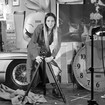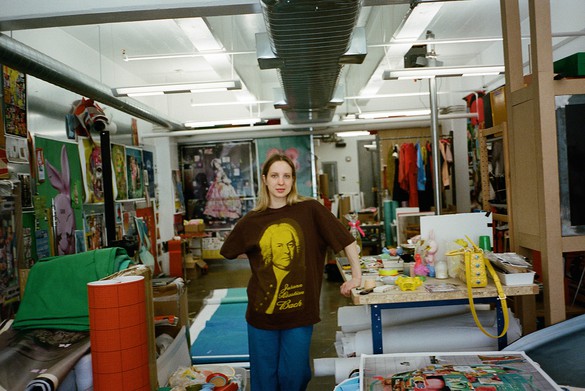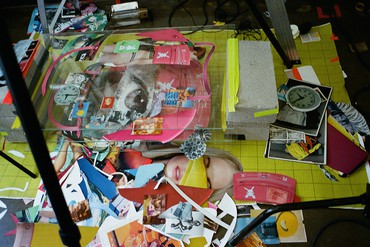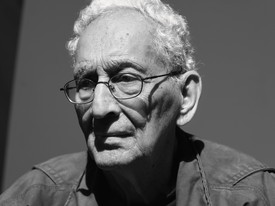
Sofia Coppola’s eighth film, Priscilla (2023), stars Cailee Spaeny and Jacob Elordi and is based on Priscilla Beaulieu Presley’s memoir Elvis and Me (1985). Coppola’s films include The Virgin Suicides (1999); Lost in Translation (2003), for which she won an Academy Award for Best Screenplay; Marie Antoinette (2006); Somewhere (2010); The Bling Ring (2013); The Beguiled (2017), for which Coppola made history as only the second woman to win the best-director prize at the Cannes Film Festival; and On the Rocks (2020).

Sara Cwynar is interested in the way that images accumulate, endure, and change in value over time. Her conceptual photographs and films involve constant archiving and re-presentation of collected visual materials, layering diverse imagery with references to art theory. The works intricately recall advertisements, retail catalogues, and old art history textbooks. Her visual assemblages meditate on how vernacular images shape collective world views, and how those ideals can change through time and contextual manipulation.
Sofia CoppolaWhen did you start making art?
Sara CwynarWhen I was about twenty. I was studying English literature and had dropped out of school. But it took me years to call myself an artist; it seemed like this sacred realm that it would be presumptuous to consider myself a part of. My way into art was through design. I worked as a designer for the New York Times for a number of years and made my own work at 5am before work and every night after. I think that design is in some ways more relevant to real life than a lot of art—our experience is now processed through the heavily designed, aestheticized filters of our virtual, app-based worlds, so I’m glad I have this background. A big thread in my work is thinking about how design and advertising work, how desire gets stirred up, and how things that are heavily designed or the most in fashion are the ones that fade into obsolescence the most quickly. I love collecting and reworking those kinds of things.
To really answer these questions, around the third year of having an office job I decided I needed to be an artist as a profession, or at least to try! I thought that at least I could see if I could make it work, and if I didn’t have my full brain to myself for a bit, I would always regret it.
SCoAs a kid, what were you making and was it related to what you’re doing now?
SCwAs a kid I was a competitive teenage figure skater with a laser focus. It took me a long time to realize, but that’s actually so relevant to what I do now. To be an artist you have to be kind of obsessive, maybe a little (or a lot!) narcissistic, willing to push yourself to extremes, obsessed with a goal that might seem insurmountable when you start—like how finishing a video feels to me when I begin. It’s like being a teenager who actually thinks she’s going to make it to the Olympics for figure skating. And just like anyone else, I don’t want to fail, but I’m also not paralyzed by the possibility of failure because of my early experiences with it as a skater: if you jump, you can’t land on your feet every time, there’ll always be times when you fall. I think this is important for art, because often you’re so in the middle of it, and it makes absolutely no sense from where you are, and you just have to trust that it will come together. Also, as an athlete you get addicted to focusing all of your energies on one goal, like a competition, and letting everything else fall away. In a way, it’s a really simple way to live. When I’m finishing a show, I feel like there’s a similar clarifying effect. I find it comforting, even though there’s often a lot of stress involved.
SCoHow did you start making the layers of collage with glass? Where did that come from?
SCwI was watching all these Disney animation videos, and that’s a process they used in early Disney animations to create perspective and a feeling of space: different elements of a scene—the trees, the sky, Bambi—would be placed on different layers of glass and moved to create a more realistic sense of depth. I was also trying to think at the time about making photographs that need to be photographs, that use the lens and the sense of depth that only a photograph gives, and that knead together different objects in ways that actually wouldn’t make sense if you tried to paint them but are acceptable to your eyes because they have this index in the real world. I was using the glass to bring things very close to the lens and very far away, and to try to confuse the scale of familiar objects. The more I got into it, the more elaborate those constructions became. My film Glass Life [2021] is shot on many layers of glass with a camera that moves over them.
SCoWho are your favorite artists or heroes?
SCwI love Agnès Varda, Steve McQueen, Jean-Luc Godard, anyone who can kind of weave something more structural, or something that acknowledges the medium and the technology of film and photography, with a narrative or personal element into a work. That’s what I try to do in my own work. I also love beauty, and play, maybe Godard and Varda do this more than McQueen. None of these artists sacrifice the look and investment in the image in order to make something more “serious” or to make a political point; the beauty is part of the politics, or part of how very serious content is delivered and absorbed, and why it needs to be a film and not an essay. That’s really important to me.
SCoWhat’s the best advice you’ve gotten, or do you have a favorite quote, or something someone told you, that sticks in your mind? I always love what Ed Ruscha said about art: that it should be “Huh? Wow.” Instead of “Wow, huh?” That’s always stayed in my mind.
SCwHaha, I love that quote. There are two things I think about a lot, though I can’t remember who said either of them to me! First is that you can always tell when an artwork starts with an idea and is organized around that idea, no matter how far from it you get. And second is that you have to actually be making something for it to sort itself out, no matter how tempting it is to sit and think around a piece for days or weeks before doing the actual work of trying to make it. These two statements kind of contradict each other, and I think, at least for me, they guide me in making work that has two totally different sides. It’s research based, but I also let intuition take over. I like to make structures that can hold in a kind of chaotic, messy working process in the studio.
Right now I’m trying to think about the second statement, because I’m actually stuck in a deep research hole but I know it’s just an elaborate and sometimes punishing form of procrastination! There’s this huge gap between thinking of an idea and seeing how it begins to actually work in the studio. It often has to be completely changed or thrown out, and I can be really tempted to just stay in that comfortable first zone where it’s just an idea that always seems like it’s going to work out.
SCODo you think about your audience, who you’re making it for? Or not? If you do, does that change each time?
SCWI think of my audience in different ways every time. Sometimes they seem like this benign, generous group of viewers out there, and I’m hoping to make things that will be pleasurable for them to watch or see, and I feel like I’ve got it. And sometimes I can only think about the most cynical, unresponsive reactions an audience might have. Both can be generative mindsets. Especially being online, where every bit of minutia is picked apart, it can be easy to imagine a judgmental audience. At some point I just try to stop thinking about it. I’m always surprised by how much things change in meaning once they go out into the world. A big goal of mine is to take heady and political ideas about the way images work, and about the latent power dynamics in images and the media, and to rework them into photographs and films that are beautiful and accessible. Hence my obsession with Varda, or Godard, who I think did this in their own times.
SCODo you know what it’s about going into it, or do you notice or figure it out later?
SCWA combo. I’m always trying to force myself to know what it’s about first, but I work a lot from intuition and things change so dramatically. Often I look back on things and don’t understand exactly what happened, or it almost feels like someone else made it.
SCoWhat do you hope to achieve in your work?
SCwThat’s a very hard question. I mostly want to make our time more clear to us, and to make documents that will speak to how it felt to be in this time after it’s over, if the documents still exist. I also have more selfish goals, like just quieting my own need to make and organize these things. Otherwise I have different goals with different works. In my last film, Glass Life, for example, I was feeling really invested in the idea of surveillance capitalism, which felt like this pressing, evil thing that I wanted to talk about in an accessible way. (I mean specifically, the way Google and other tech companies are watching and monetizing everything we do, and we have no space to live outside of a constant presence and participation. I was very moved by Shoshana Zuboff’s 700-page book The Age of Surveillance Capitalism [2018].) But I also wanted to work through my own archive, and to somehow organize it all, get some perspective on it, and do this personal, very detail-oriented work in the studio alone for over a year, which is how making the film was. I was thinking about the Internet as a giant archive, and about how my own collection was a piece of that, and what it would look like if it was organized around the idiosyncracies of one person’s mind. A lot of the time I’m trying to connect larger political or historical ideas to individual pictures or designed objects, to show the world in a weirder way. I guess that’s the goal of most artists.
SCoWhat’s your favorite and least favorite part of making your work?
SCwHands down my least favorite part is actually taking pictures! I like thinking about them, I love moving the things around that will be in them, I love planning them, I love editing them, I hate shooting them. I always feel like there’s something I’m missing, or something that could have been better. And I’m often running up and down a ladder to shoot things on the floor. Oddly, I’ve discovered that I like it a bit better if I do it in the middle of the night, so now I shoot a lot of my photos at 2am.
SCoWhat’s your ideal day?
SCwProbably just being in the studio. And it would also involve walking around New York City. Followed by a beer.
SCoDo you have a favorite museum or favorite place where you’ve seen art?
SCwThe Calouste Gulbenkian Museum in Lisbon, Portugal. The displays are so beautiful, they’re artworks in themselves. I also love the New York Public Library Picture Collection, which feels like a museum to me. And all the museums in New York, particularly the Met and MoMA. I think you just have a special relationship with the ones you go to all the time, where you can see how the spaces change for each artist.













